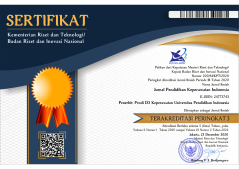Nomophobia in Nursing Students at Padjadjaran University
Abstract
ABSTRACT
During the industrial revolution of 4.0, everything becomes easily accessible. One of its developments is information and communication technology. The high use of a smartphone as communication tools can cause dependency which is characterized by repeatedly checking smartphones which can cause addiction so that it can cause fear or phobia, commonly known as Nomophobia. The aim of this study was to determine the overview of nomophobia in Nursing students at Padjadjaran University. This research used a quantitative descriptive method with cross-sectional approach. Samples were taken using a total sampling technique from the population of an active student of the Bachelor program in the year of 2016, 2017, 2018 and 2019 Faculty of Nursing, Padjadjaran University. Data were collected using the Nomophobia Questionnaire (NMP-Q) and analyzed using descriptive frequency distribution. The results of this study showed that the majority of respondents 559 (63.5%) showed moderate nomophobia, as many as 243 respondents (27.6%) showed severe nomophobia and 79 respondents (9%) showed mild nomophobia. The conclusion of this study is that majority of respondents belong to the category of moderate nomophobia. Therefore, it is recommended for the following institution to be able to develop policies that regulate the use of smartphones in the context of clinical education and practice.
ABSTRAK
Pada era revolusi industri 4.0 segala sesuatunya semakin mudah diakses. Salah satu perkembangannya adalah teknologi informasi dan komunikasi. Tingginya penggunaan alat komunikasi smartphone dapat menimbulkan ketergantungan yang ditandai dengan selalu memeriksa smartphone yang dapat menimbulkan suatu kecanduan sehingga dapat menimbulkan ketakutan atau fobia yang lebih dikenal dengan sebutan Nomophobia. Tujuan penelitian ini adalah untuk mengetahui gambaran nomophobia pada mahasiswa Fakultas Keperawatan Universitas Padjadjaran. Penelitian ini menggunakan metode deskriptif kuantitatif dengan pendekatan cross sectional. Sampel diambil dengan menggunakan teknik total sampling dari populasi mahasiswa aktif program Sarjana angkatan 2016,2017,2018 dan 2019 Fakultas Keperawatan Universitas Padjadjaran. Data dikumpulkan dengan menggunakan instrumen Nomophobia Questionnaire (NMP-Q dan dianalisis secara deskriptif distribusi frekuensi. Hasil penelitian ini menunjukkan bahwa sebagian besar responden 559 (63,5%) menunjukkan nomophobia sedang, sebanyak 243 responden (27,6%) menunjukkan nomophobia berat dan sebanyak 79 responden (9%) menunjukkan nomophobia ringan. Simpulan dari penelitian ini adalah sebagian besar responden tergolong kedalam kategori nomophobia sedang. Oleh karena itu, disarankan bagi pihak instansi untuk dapat mengembangkan kebijakan yang mengatur penggunaan smartphone dalam konteks pendidikan dan praktikum klinis.
Keywords
Full Text:
PDFReferences
Adiansah, W., Setiawan, E., Kodaruddin, W. N., & Wibowo, H. (2019). Person in Environment Remaja Pada Era Revolusi Industri 4.0. Focus : Jurnal Pekerjaan Sosial, 2(1), 47. https://doi.org/10.24198/focus.v2i1.23118
Aguilera-Manrique, G., Márquez-Hernández, V. V., Alcaraz-Córdoba, T., Granados-Gámez, G., Gutiérrez-Puertas, V., & Gutiérrez-Puertas, L. (2018). The relationship between nomophobia and the distraction associated with smartphone use among nursing students in their clinical practicum. PLoS ONE, 13(8), 1–14. https://doi.org/10.1371/journal.pone.0202953
Ayar, D., Özalp Gerçeker, G., Özdemir, E. Z., & Bektaş, M. (2018). The Effect of Problematic Internet Use, Social Appearance Anxiety, and Social Media Use on Nursing Students’ Nomophobia Levels. CIN - Computers Informatics Nursing, 36(12), 589–595. https://doi.org/10.1097/CIN.0000000000000458
Bivin, J., Mathew, P., Thulasi, P., & Philip, J. (2013). Nomophobia-Do We Really Need To Worry About? 1–5. http://figshare.com/articles/Comparision_Of_Two_Dna_Extraction_Methods_Using_The_RT_PCR/709549
Chandak, D. P., Singh, D. D., Faye, D. A., Gawande, D. S., Tadke, D. R., Kirpekar, D. V, & Bhave, D. S. (2017). An Exploratory Study of Nomophobia in Post Graduate Residents of a Teaching Hospital in Central India. The International Journal of Indian Psychology, 4(3), 48–56.
Cheever, N. A., Rosen, L. D., Carrier, L. M., & Chavez, A. (2014). Out of sight is not out of mind: The Impacat of restricting wireless mobile device use on anxiety levels among low, moderate and high users (pp. 290–297). Computers in Human Behaviour.
Daei, A., Ashrafi-rizi, H., & Soleymani, M. R. (2019). Nomophobia and Health Hazards: Smartphone Use and Addiction Among University Students. International Journal of Preventive Medicine, 8, 1–5. https://doi.org/10.4103/ijpvm.IJPVM
Dasgupta, P., Bhattacherjee, S., Dasgupta, S., Roy, J. K., Mukherjee, A., & Biswas, R. (2018). Nomophobic behaviors among smartphone using medical and engineering students in two colleges of West Bengal. Indian Journal of Public Health, 62(1), 70. https://doi.org/10.4103/ijph.IJPH_407_17
Databoks. (2016). Pengguna Smartphone di Indonesia 2016-2019. Katadata.Co.Id. https://databoks.katadata.co.id/datapublish/2016/08/08/pengguna-smartphone-di-indonesia-2016-2019
Effendi, N., & Widiastuti, H. (2014). Hubungan Ketergantungan Smartphone dengan Kecemasan. Jurnal Kesehatan, 7(2), 353–360. https://doi.org/10.24252/kesehatan.v7i2.54
Fukada, M. (2018). Nursing Competency: Definition, Structure and Development. Yonago Acta Medica, 61, 1–007.
Gonçalves, S., Dias, P., & Correia, A. (2020). Nomophobia and lifestyle : Smartphone use and its relationship to psychopathologies. Computers in Human Behavior Reports, 2, 100025. https://doi.org/10.1016/j.chbr.2020.100025
Gupta, R. (2019). Nomophobia : A Smartphone Addiction. 7(1). https://doi.org/10.25215/0701.110
Herman, N., Pentek, T., & Otto, B. (2015). Design Principles for Industrie 4.0 Scenarios: A Literature Reviwq. 01.
Kanmani, A. (2018). NOMOPHOBIA – An Insight into Its Psychological Aspects in India. May.
Kemendikbud. (2018). Nomophobia. Inspektorat Jenderal Kementerian Pendidikan Dan Kebudayaan. https://itjen.kemdikbud.go.id/public/post/detail/nomophobia
Kendall. (1998). Abnormal Psychology Human Problems Understanding Second Edition. Houghton Mifflin Company.
Lee, Y. K., Chang, C. T., Lin, Y., & Cheng, Z. H. (2014). The dark side of smartphone usage: Psychological traits, compulsive behavior and technostress. Computers in Human Behavior, 31(1), 373–383. https://doi.org/10.1016/j.chb.2013.10.047
Musdalifa. (2017). KEBUTUHAN AFILIASI DAN NOMOPHOBIA MAHASISWA UNIVERSITAS NEGERI MAKASSAE. 3, 43. https://doi.org/10.1017/CBO9781107415324.004
Newzoo. (2019). Top Countries by Smartphone Users. https://newzoo.com/insights/rankings/top-countries-by-smartphone-penetration-and-users/
Oliveira, T. S., Barreto, L. K. D. S., El-Aouar, W. A., Souza, L. A. De, & Pinheiro, L. V. D. S. (2017). CADÊ MEU CELULAR? UMA ANÁLISE DA NOMOFOBIA NO AMBIENTE ORGANIZACIONAL. RAE Revista de Administracao de Empresas, 57(6), 634–635. https://doi.org/10.1590/s0034-759020170611
Passaddhi, A. F. (2015). Menggunakan Smartphone Secara Bijak dengan Pengendalian Diri (Sainvara) Bagi Mahasiswa. 1–7.
Rachman, L. S., Ma, L., & Ibnu, F. (2019). HUBUNGAN ANTARA HARGA DIRI DENGAN NOMOPHOBIA PADA PENGGUNA SMARTPHONE DI KELAS X SMAN 2 MOJOKERTO.
Rodríguez-García, A. M., Belmonte, J. L., & Moreno-Guerrero, A. J. (2020). Nomophobia: An individual’s growing fear of being without a smartphone—a systematic literature review. International Journal of Environmental Research and Public Health, 17(2). https://doi.org/10.3390/ijerph17020580
Rossa, E., & Martina, M. (2016). Smartphone Addiction dengan Kecenderungan Nomophobia pada Mahasiswa Fakultas Keperawatan Universitas Syiah Kuala. Jurnal Ilmiah Mahasiswa Fakultas Keperawatan, 1(1).
Sudarji, S. (2018). Hubungan Antara Nomophobia Dengan Kepercayaan Diri. Psibernetika, 10(1), 51–61. https://doi.org/10.30813/psibernetika.v10i1.1041
Ulfah, S. A., & Syafrizaldi. (2017). Perbedaan Kematangan Emosi Ditinjau dari Jenis Kelamin pada Remaja di SMAS Sinar Husni Medan. Jurnal Diversita, 3(2), 59–65.
Yildirim, C. (2014). Exploring the dimensions of nomophobia: Developing and validating a questionnaire using mixed methods research. http://lib.dr.iastate.edu/etd
DOI: https://doi.org/10.17509/jpki.v6i2.26292
Refbacks
- There are currently no refbacks.
Jurnal Pendidikan Keperawatan Indonesia(JPKI) published by Indonesia University of Education. JPKI is licensed under a Creative Commons Attribution-ShareAlike 4.0 International License.
Office :
Nursing Department. FPOK UPI.
229, Dr. Setiabudhi Street. Bandung 40154
West Java , Indonesia
E-mail : jpki@upi.edu

_.png)
_.png)
_.png)











